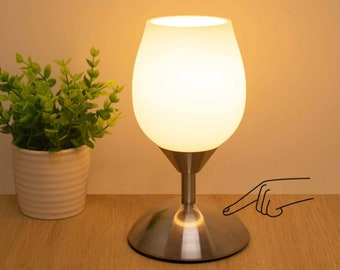Touch Sensor Metal Lamps: How Do They Work?
Touch sensor metal lamps. What are they? How do they work? And where did they go? Anyone who lived through the 80’s and 90’s as a tech-savvy adult has seen, has owned, or at the very least, knows about touch sensory metal lamps. If you are one of the unfortunate few who don’t know about them, we want to tell you all about them!

What is it? Warning: Personal Experience Montage
Firstly, I personally had a touch sensor metal lamp growing up. My mother bought one for me and my sisters shared bedroom when we were adolescents. Now, the design itself wasn’t exactly the most “sleek and modern” lamp I’ve ever laid eyes on, but it had a sweet and traditional shape with floral accenting and a necessary full metal body in a bright gold-finish. It was reminiscent of a classic Tiffany’s lamp design.
A lamp is just a lamp at that age, until I realized I could simply touch any part of it (that was metal) and it would turn on! Then came the added bonus – tap it once to turn on, tap it twice to brighten, tap it three times to turn off. It was like magic! Of course, it was science – like most things called “magic” when we don’t know any better, but it was mesmerizing nonetheless.
How do they work?
Touch lamps work with no external switch designed for turning on and off. Some of the better versions can also have the capacity to increase or decrease brightness the same way a dimmer switch does.They work by a process called capacitance. To be more specific, body capacitance. Body capacitance is the “physical property of the human body that has it act as a capacitor.” This is similar to the way touch screens on cell phones and other touch sensory devices operate.
To continue, the electrical switch in a touch lamp is inside of it, not outside of it. Our bodies hold a certain and specific capacity to hold an electrical charge. Therefore, we are able to control the on / off functionality of a touch sensor lamp by using our fingertips. Of course, there is more science that goes into the basics of electrical currents, capacitance, metal conductors, and other properties of a touch sensor lamp, including our fingertips themselves! I encourage anyone interested in more of the science behind it to explore other resources to read about the specifics on how touch sensory lamps work.
Where did they go?
Touch sensor lamps were said to be invented in the mid-1950’s. They did not popularize until the mid-1980’s because like many great inventions of an era, the cost to make them was more expensive than would be feasible to sell commercially. Today, touch sensor lamps still exist. In fact, there are many different styles of touch sensor lamps. And no, not all are as whimsical and homely as my first touch lamp I had as a kid.

There is a likelihood, touch lamps decreased in popularity due to the nature of fads. When something isn’t known about, isn’t talked about, or doesn’t stay in the mainstream marketplace, many people have a tendency to forget about them. While others might have never known they exist.
Progress, development and technology can also play important roles in the continuance of anything. But, we do find it ironic because the majority of lamps in households today are using the same external and (outdated) switches in their lighting.
An amazing inventor named Buckminster Fuller said, “You never change things by fighting the existing reality. To change something, build a new model that makes the existing model obsolete.”
Does anyone really want to fumble around in the dark to find the switch to turn the light on? As much as we enjoy variety in design, we are saying “YES! Let’s see more touch lamps!” It would be much more convenient to reach out our hand, and gently using our own body capacitance, touch lamp to turn it on.